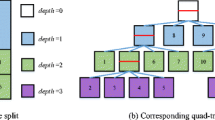Abstract
The H.264/AVC video coding standard adopted context-based adaptive variable length coding (CAVLC) as an entropy coding tool. By combining adaptive variable length coding (VLC) with context modeling, we can achieve a high coding performance. However, CAVLC in H.264/AVC has the problem that VLC table prediction is not always accurate. In this paper, we propose a new VLC table prediction algorithm using the correlation between coding modes of the current and neighboring sub-blocks and the statistics of mode distribution in both intra and inter frames. In addition, we can further increase correctness of VLC table prediction considering the structural characteristics of mode information in inter frames. Experimental results show that the proposed algorithm increases correctness of VLC table prediction by 10.07% and reduces the bit rate by 1.21% on average without significant increment of encoding time.
Similar content being viewed by others
References
Joint Video Team of ITU-T and ISO/IEC JTC 1 (2003). Draft ITU-T recommendation and final draft international standard of joint video specification (ITU-T Rec. H.264 | ISO/IEC 14496-10 AVC), Doc. JVT-G050, March 2003.
Wiegand, T., Sullivan, G. J., Bjontegaard, G., & Luthra, A. (2003). Overview of the H.264/AVC video coding standard. IEEE Transactions on Circuits and Systems for Video Technology, 13(7), 560–576.
Sullivan, G. J., & Wiegand, T. (2005). Video compression—from concepts to the H.264/AVC standard. Proceeding of the IEEE, 1, 18–31.
Luthra, A., Sullivan, G. J., & Wiegand, T. (2003). Introduction to the special issue on the H.264/AVC video coding standard. IEEE Transactions on Circuits and Systems for Video Technology, 13(7), 557–559.
Richardson, I. E. G. (2003). H.264 and MPEG-4 video compression—video coding for next-generation multimedia. New York: Wiley.
Bjontegaard, G., & Lillevold, K. (2002). Context-adaptive VLC (CVLC) coding of coefficients. JVT Document JVT-C028, May 2002.
Sayood, K. (2003). Lossless compression handbook. San Diego: Academic Press.
Malvar, H., Hallapuro, A., Karczewicz, M., & Kerofsky, L. (2003). Low-complexity transform and quantization in H.264/AVC. IEEE Transactions on Circuits and Systems for Video Technology, 13(7), 598–603.
Sullivan, G. J., & Wiegand, T. (1998). Rate-distortion optimization for video compression. IEEE Signal Processing Magazine, 15, 74–90.
JVT Reference Software JM 11.0, available online at: http://iphome.hhi.de/suehring/tml/download/jm_old/jm11.0.zip.
Author information
Authors and Affiliations
Corresponding author
Rights and permissions
About this article
Cite this article
Heo, J., Ho, YS. VLC table prediction for CAVLC in H.264/AVC using correlation, statistics, and structural characteristics of mode information. Telecommun Syst 52, 1633–1641 (2013). https://doi.org/10.1007/s11235-011-9656-4
Published:
Issue Date:
DOI: https://doi.org/10.1007/s11235-011-9656-4




